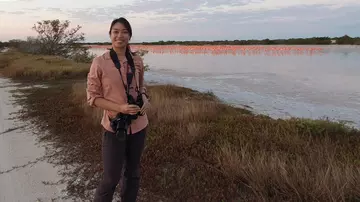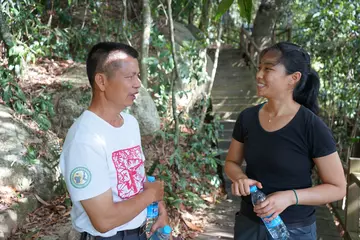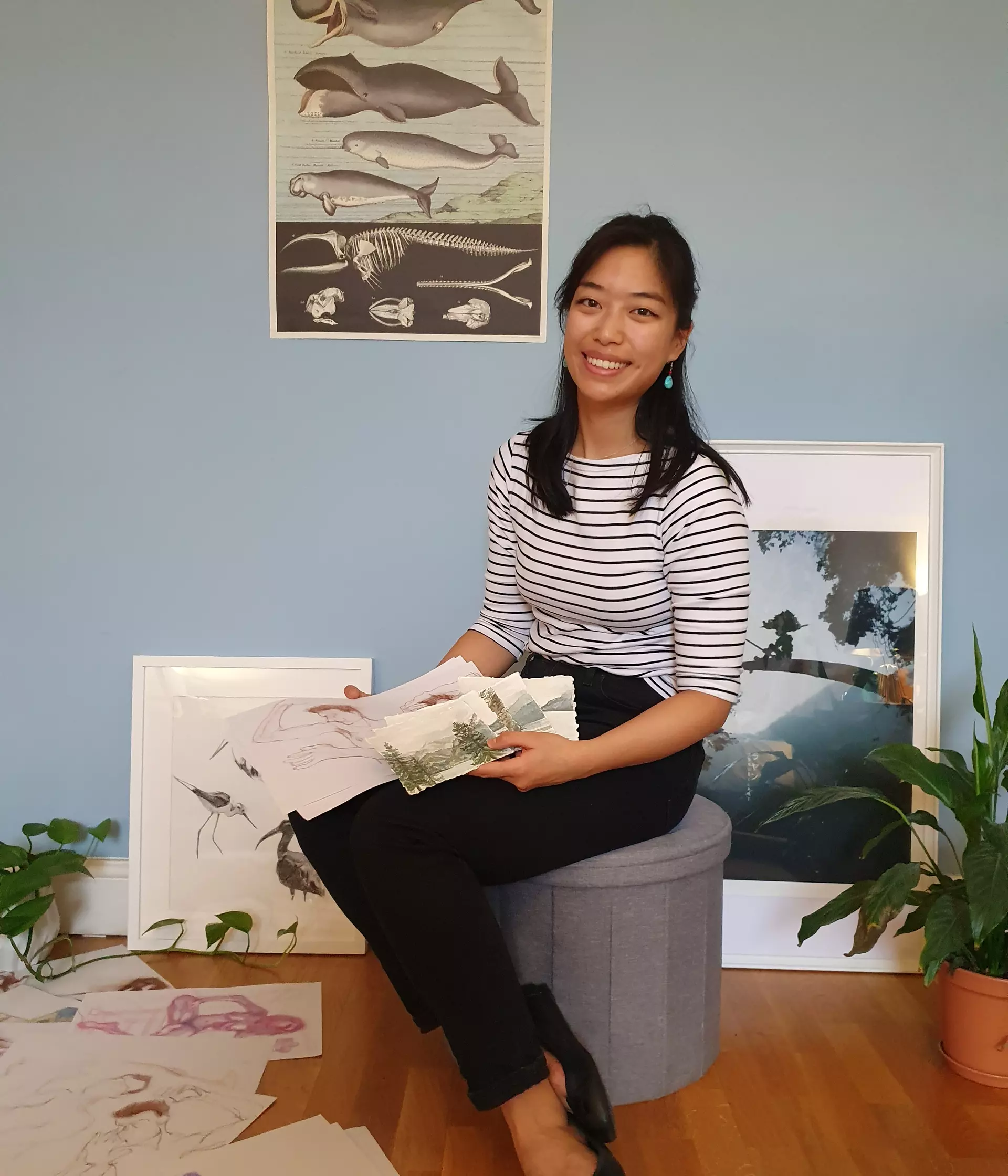
Institute of Zoology
Regent's Park
London
NW1 4RY
United Kingdom
Dr Heidi Ma is interested in biodiversity conservation and pressing environmental issues in regions where a strong evidence base is most needed for making effective policies.
Asia is a particularly interesting region that contains an enormous amount of threatened biodiversity. China is a country rich in biodiversity and at the junction of rapid social and economic change, severe ecological degradation, and emerging environmental awareness, which raises numerous challenging yet fascinating questions for science and policy. She is also interested in finding solutions to minimise trade-offs between conservation and development.

Heidi's PhD research uses nature reserves in Hainan Province, China as a case study to explore the relationships between rural low-income local communities and biodiversity in and around protected areas. Employing local ecological knowledge and other quantitative social science methods, her research aims to understand various aspects of social-ecological system dynamics including:
1) the patterns of local people’s reported natural resource use including their motivations and attitudes;
2) the effectiveness of conservation awareness-raising campaigns and what people tend to remember about them;
3) how communities perceive the causes of decline and extinction of wildlife and whether they accept responsibility for local biodiversity loss; and
4) the variation in local ecological knowledge of traded species.

Conservation
Heidi's current role as a China-based coordinator for the Hainan Gibbon Project involves ensuring ZSL research projects are carried out on the ground, co-supervising local students, management of equipment and data, engaging with stakeholders, networking with existing and potential partners, translation, planning logistics for field work and facilitating visits of ZSL staff to China.
Find out more about the Hainan Gibbon Project
Our project contributes to the work of IUCN Primates Section on Small Apes to conserve all gibbon species in Asia. Heidi translates technical documents such as the Best Practice Guidelines for gibbon translocation and rehabilitation (abridged version) into Chinese, and facilitates international workshops, including the Hainan Gibbon Emergency Response Plan Meeting in 2016 and the Workshop on Conservation and Management of Chinese gibbons in 2018.
She also support ZSL’s wider research and conservation work in China on the Yangtze finless porpoise, the pangolin and illegal wildllife trade, the blue-crowned laughingthrush, and the Yangtze alligator. Together with her supervisor Samuel Turvey, they initiated the UK-China Conservation network in 2017 to connect UK conservation organisations and scientific research institutions each other, share contacts and resources in both China and the UK, and to help build conservation capacity in China.
Listen to the ZSL Wild Science Podcast, Episode #9 Collaborating for Conservation in China to find out more.
Art
Heidi studied art for more than 15 years with a focus on drawing and painting. She finds inspiration in the natural environment and through traveling. In 2014 and 2017, she and IoZ colleague Valentina Marconi and co-organised two staff and student art exhibitions, in which more than 30 artists across ZSL’s various departments participated. More of her artwork can be found on her website and Instagram @heidima825. She takes commissions and donates art for charity fundraising (not limited to conservation charities). If you have a good cause to support, please do get in touch.
- 2017-2021: Ph.D Biological Sciences, Royal Holloway University of London
- 2016-Present: Hainan Gibbon Project Coordinator, Institute of Zoology
- 2014-2015: Research Intern, Indicators and Assessments Unit, Institute of Zoology
- 2013-2014: M.Sc. Biodiversity Conservation and Management, School of Geography and the Environment, University of Oxford
- 2013, 2014: Research Intern, CGIAR-World Fish Center, Bangladesh and South Asia Office
- 2009-2013: B.Sc. Environmental Studies, Minor in Visual Arts, Emory University
Ma, H., Zhang, D., Xiao, L., Wang, Y., Zhang, L., Thompson, C., Chen, J., Dowell, S.D., Axmacher, J.C., Lü, & Turvey, S.T. (In press). Integrating biodiversity conservation and local community perspectives in China through human dimensions research. People and Nature.
Lin, M., Turvey, S.T., Liu, M., Ma, H., & Li, S. (2022). Lessons from extinctions of dugong populations. Science, 378 (6616): 148. Link
Turvey S.T., Ma, H., Zhou T., Teng, T., Yu, C., Archer, L.J., Rao, X., Dowell, S.D., Liang, W., Liu, H. (2022). Local ecological knowledge and regional sighting histories of Hainan Peacock-pheasant Polyplectron katsumatae: pessimism or optimism for a threatened island endemic? Bird Conservation International, 1–9. Link
Lin M., Turvey, S.T., Han, C., Huang, X, Mazaris, A.D., Liu, M., Ma, H., Yang, Z., Tang, X., & Li, S. (2022). Functional extinction of dugongs in China. Royal Society Open Science, 9, 211994. Link
Ma, H., Papworth, S. K., Qian, J., & Turvey, S. T. (2022). The medium over the message: Differential knowledge of conservation outreach activities and implications for threatened species. Journal of Environmental Management. 301, 114716. Link
Archer, L. J., Müller, H. S., Jones, L. P., Ma, H., Gleave, R. A., da Silva Cerqueira, A., McMurdo Hamilton, T., & Shennan-Farpón, Y. (2022). Towards fairer conservation: perspectives and ideas from early-career researchers. People and Nature. 4(3), 612-626. Link
Ma, H., Papworth, S. K., Ge, T., Wu, X., Yu, C., Zhang, H. & Turvey, S. T. (2021). Local awareness and interpretations of species extinction in a rural Chinese biodiversity hotspot. Frontiers in Conservation Science, 2(68956). Link
Dufourq, E., Durbach, I., Hansford, J. P., Hoepfner, A., Ma, H., Bryant, J. V., … Turvey, S. T. (2021). Automated detection of Hainan gibbon calls for passive acoustic monitoring. Remote Sensing in Ecology and Conservation, 1–13. Link
Qian, J., Mills, M., Ma, H. & Turvey, S. T. (2021). Assessing the effectiveness of public awareness-raising initiatives for the Hainan gibbon Nomascus hainanus. Oryx, 56 (2): 249-259. Link
Liu, H., Ma, H., Cheyne, S. M. & Turvey, S. T. (2020). Recovery hopes for the world’s rarest primate. Science, 368 (6495), 1074. Link
Han, C.T., Liu, M. M., Ma, H., Lin, M. M. & Li, S. H. (2020) Applications and prospects of local ecological knowledge in marine mammal research. Biotic Resources, 42 (3), 263-270. [In Chinese] Link
Chen, J. Y., Cheyne, S. M., Dee, J., Ge W. H., Ma, H., Qian J. F., Thompson, C., Turvey, S. T., Yan, L., Yang, C. T. & Zhang, W. B. (Eds). 2019. Chinese Gibbon Conservation and Population Management Workshop, Guangzhou, Guangdong, China, 22-23 April, 2018. IUCN SSC SSA. 122pp. Link
Böhm, M., Cook, D., Ma, H., Davidson, A. D., García, A., Tapley, B., Pearce-Kelly, P. & Carr, J. (2016). Hot and bothered: using trait-based approaches to assess climate change vulnerability in reptiles. Biological Conservation, 204(A), 32-41. Link
Campbell, C.O. & Cheyne, S.M. (2017). Chinese Summary, Best Practice Guidelines for Gibbon Rehabilitation and Translocation. Gland, Switzerland: IUCN SSC Primate Specialist Group. 11pp. [In Chinese] Link
